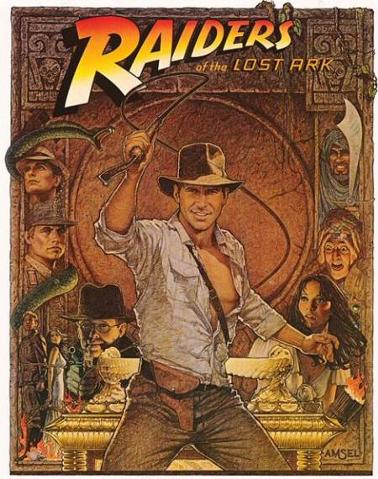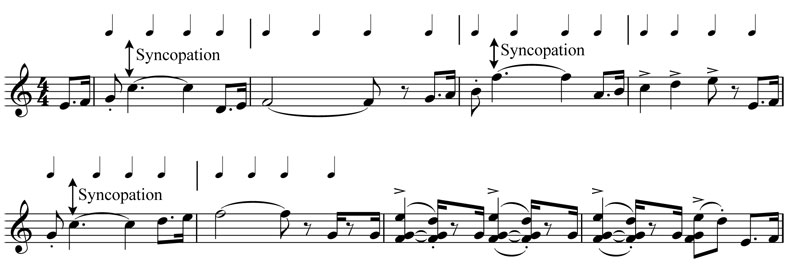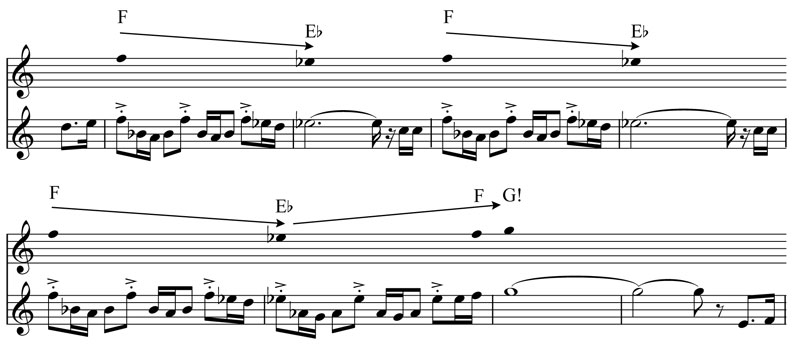 Ever since its first appearance in Raiders of the Lost Ark, the Raiders March has been such a recognizable symbol of Indiana Jones that we associate it with the character as much as we do his trademark bullwhip and fedora. And like other John Williams themes, it’s not just that the theme represents the character, but that it does so in such an appropriate way that it would be hard to imagine something different working this well. In large part, this is because of Williams’ remarkable ability to coordinate many different parameters of the music with various facets of the thing it represents, in this case, Indy himself.
Ever since its first appearance in Raiders of the Lost Ark, the Raiders March has been such a recognizable symbol of Indiana Jones that we associate it with the character as much as we do his trademark bullwhip and fedora. And like other John Williams themes, it’s not just that the theme represents the character, but that it does so in such an appropriate way that it would be hard to imagine something different working this well. In large part, this is because of Williams’ remarkable ability to coordinate many different parameters of the music with various facets of the thing it represents, in this case, Indy himself.
The march is divided into a large three-part form, of which the first part is Indy’s theme, the second Marion’s theme, and the third an abbreviated return to Indy’s theme. Since we’re talking about Williams’ depiction of the Indy character here (and since the third part largely repeats the first), my film music analysis will focus mainly on the first part.
This first section itself breaks down into a three-part ABA form, the A and B sections using different but related melodic ideas. Williams had initially composed the melodies of both as possibilities for the opening of Indy’s theme. When he approached Steven Spielberg (director of Raiders of the Lost Ark) with the themes, asking which one he would prefer, Spielberg loved them so much that he said “well, can’t you use both?” And so Williams did, one in the A section, the other in the B section (or “bridge”). Below is an audio clip of the entire march. The B section starts at 0:36:
The A Section
Melody
The famous melody that begins the march already suggests much of Indy’s character. First, it is played by four trumpets in unison, and every one of its short motives starts with a militaristic dotted rhythm, both giving the sense that this is a hero’s theme (see the brackets below):

But also notice that in every other bar, there are syncopations (off-beat accents) after the first beat and just before the fourth beat of each bar (most clearly heard in the opening four bars before the melody comes in):
 These syncopations add a buoyancy and lightness to the march, and signal some of Indy’s less serious, “fun” side.
These syncopations add a buoyancy and lightness to the march, and signal some of Indy’s less serious, “fun” side.
Then there’s the melody’s shape as a whole. The first six motives we hear move completely in the upward direction (and even the seventh begins by rising), lending the theme and Indy a very positive feel (by contrast, recall from Part 3 of this series that the Imperial March was based largely on descending motives):
 Overall, the highest notes in these motives form a rising contour from C up to F. But also notice that in between each of these high notes, there is a drop down to a lower note. Naturally, the rising contour gives us the feeling of aspiring to something better in the manner of a hero. But the drops in between lower the tension and create a more relaxed heroic sound than would a constant striving higher and higher, as in the Force Theme, for instance (see Part 1 of this series). And certainly this accords with Indy’s confident brand of heroism in that he’s never really fazed by anything (well, anything but snakes!).
Overall, the highest notes in these motives form a rising contour from C up to F. But also notice that in between each of these high notes, there is a drop down to a lower note. Naturally, the rising contour gives us the feeling of aspiring to something better in the manner of a hero. But the drops in between lower the tension and create a more relaxed heroic sound than would a constant striving higher and higher, as in the Force Theme, for instance (see Part 1 of this series). And certainly this accords with Indy’s confident brand of heroism in that he’s never really fazed by anything (well, anything but snakes!).
The opening motive of the melody includes the upward leap of a fourth, which again suggests a hero, but this fourth is slightly smaller than the fifth that opens Williams’ other heroic themes like those for Superman and Star Wars. Actually, recall from Part 2 in this series that the Star Wars main title theme even involved the “superhuman” leap of a seventh (which is part of the Superman theme as well). And although all three themes are stated in the trumpets, Indy’s theme is in a slightly lower register than the others, and so is not given the same superhero status. Compare them all below:
Raiders March

Star Wars
 Superman
Superman
 The smaller leap of Indy’s theme suggests a hero that is more human and “down to earth”. After all, Indy usually doesn’t overcome his enemies through some kind of superhuman strength or power, but with his ingenuity. (This is emphasized by the fact that he is a university professor by trade.) At the end of Raiders, for example, he shuts his eyes (and tells Marion to do the same) before the spirits from the Ark turn deadly. And in Indiana Jones and The Last Crusade, he reasons that since Jesus was a carpenter, his cup at the Last Supper (the Holy Grail) would have been one made of wood, not metal. In both cases, it is Indy’s knowledge that saves him from perishing like his Nazi foes.
The smaller leap of Indy’s theme suggests a hero that is more human and “down to earth”. After all, Indy usually doesn’t overcome his enemies through some kind of superhuman strength or power, but with his ingenuity. (This is emphasized by the fact that he is a university professor by trade.) At the end of Raiders, for example, he shuts his eyes (and tells Marion to do the same) before the spirits from the Ark turn deadly. And in Indiana Jones and The Last Crusade, he reasons that since Jesus was a carpenter, his cup at the Last Supper (the Holy Grail) would have been one made of wood, not metal. In both cases, it is Indy’s knowledge that saves him from perishing like his Nazi foes.
Harmony
The march begins with four bars of accompaniment that repeat a single C major chord. This major chord not only gives the march a positive connotation from the get go, but because it is the tonic chord of that key, it has a very stable sound and its repetition gives us the impression we are “in good hands” with Indy.
This stable sound continues when the familiar tune starts up, as the bass remains fixed to the C even when the chords overtop change, creating what is known as a pedal point in the bass. At least for these opening bars, it seems as if nothing can shake our hero.
With the sixth bar of the melody, however, we hear a chord (bII, or the “Neapolitan”) that, for the first time, sounds notes outside of the C major key. This presents a challenge to the that key, and because the notes of the chord are “flat” compared to the major key, they have a slightly ominous quality to them. In short, the music seems to be questioning the hero at this point, presenting him with a potential danger that he must overcome.
And overcome it, he certainly does! Not only does the music return to the brighter colors of C major, banishing the gloomy sounds of the flats, but it does so with such panache and style that we are certain of the success of our hero: the trumpets and trombones together sound a loud fanfare that marks the climax of the melody’s eight bars. Not only that, but for the first time in the theme, the motive now takes a downward turn, descending by step, as though Indy is literally overcoming some obstacle. And we hear this descending step four times in a row, leaving no doubt in our minds that Indy will succeed in his adventures.
The B Section
Melody
The B section begins after a repetition of the A section, and starts with the alternative melody Williams had considered for the march’s opening. This section is somewhat more serious in character owing largely to the way in which Williams works out this new melody. Its short motives continually rise to F, but then fall to E:

The melody here can’t seem to get any higher in the scale than the E (of course the melody leaps up to the E an octave higher, but this is still an E and isn’t any higher in the scale than the previous E). In fact, the melody moves even further downward as the melody continues, through Eb, D, and stopping on C.
This is why I say that the B section takes on a more serious character: we actually feel a bit of the hero’s struggle in the music here. In other words, the melody’s motives begin by rising a step, suggesting something positive, but then fall back down a step, suggesting a setback of some kind. As we saw in Part 1 of this series, these kinds of downturns in a rising melody are partly why the Force Theme sounds like so much of a struggle and is ideal for representing the Jedis’ fight against the Empire. In the Raiders March, however, these downward turns are overcome at the end of the B section, where, after falling from F a few more times, the brass finally reach up a step higher than the F to G and blast it out on a long held note:

Harmony
The stable sound of the pedal point we heard at the march’s opening returns to start the B section with a repeated C in the bass. Nearly the entire B section is propped up by this pedal, which again speaks to Indy’s confidence even in the face of the struggles suggested by the rising-falling melody.
At the same time, almost every chord used in this B section is a major chord (some with an added seventh). This injects a strong positive element into the sound of the struggle here despite the more ominous flats appearing in some of the chords (bVII and bVI). Like the march’s A section, the music seems to be saying that the struggles Indy will face won’t be anything he can’t overcome, even if they seem to challenge him at times. Again, we are in good hands here.
The March as a Whole
Over the course of the entire Raiders March, the main Indy Theme (the A section) is stated a total of six times. But these statements are far from exact repetitions. In fact, Williams has scored them in such a way that they actually intensify as the march progresses, making the final statement the most climactic, which not only concludes the piece with dramatic flair, but leaves no doubt in our minds that Indy will always succeed in his adventures. Below is the recording once more along with a summary of what Williams does and doesn’t change with each statement:
Statement 1 (start of march, at 0:07)
- C major
- Thin scoring
- Melody only in trumpets
- Accompaniment in trombones, timpani, cello, and bass
- Medium-loud dynamics (mezzo forte)
Statement 2 (immediately after Statement 1, at 0:22)
- C major
- Winds and cymbals added
- Medium-loud dynamics (mezzo forte)
Statement 3 (after B section, at 1:17)
- C major
- Thicker scoring:
- Melody now in trumpets, trombones, glockenspiel, and all winds
- Accompaniment in all strings, snare drum added
- Louder dynamic (forte)
Statement 4 (immediately after Statement 3, at 1:35)
- Db major (a half-step higher than C major, more intense)
- Thicker scoring (as in Statement 3)
- Even louder dynamic (fortissimo)
- Melody is now imitated by the trombones, creating a more active texture
Statement 5 (after Marion’s Theme, at 4:28)
- F major (a third higher than the previous statement in Db major, more intense)
- More brilliant scoring:
- Rapid flourishes added in the winds
- Accompaniment made heavier with addition of trombones and tuba to the timpani and all the strings
- Bass drum added to every beat
Statement 6 (immediately after Statement 5, at 4:42)
- Still in F major
- More cymbal crashes added
- Melody imitated in trombones (as in Statement 4)
Conclusion
The Raiders March isn’t just a great tune. Like so many Williams themes, it is an apt reflection of the character it represents. Not only does it capture Indy’s heroism and confidence, but it also incorporates the fun, lighter side of Indy’s personality. It is also fitting that Indy’s music should lack the overwhelming grandiosity of other superheroes’ themes since his victories are more brainy than brawny. His music also portrays him as more of a human, earthbound type of hero than, say, Luke Skywalker or Superman. Instead, this is an untroubled kind of music for an untroubled kind of hero, one who always achieves a clear success. Even so, his adventures and his music are still a source of tremendous excitement.
Coming soon… John Williams Themes, Part 5: The Theme from Jurassic Park
This is a really wonderful article! As a student studying music the analysis you make of the piece not only makes me appreciate John Williams’ genius even more, but will undoubtedly help me to compose my own music better. Well done, a real treasure!
Thanks, Adam! Glad you like the article. Another Williams post will be coming out in June on his Superman theme as a prelude to Zimmer’s Man of Steel score, which I hope to write about as well. Cheers.
Concerning the Superman themes, I can’t wait to read your posts in June.
Do you think that it is apropos for the new film to completely scrap the JW music and go with the newer modern sounds of Zimmer?
I personally love JW’s music and find it hard to believe that Zimmer can write anything that musically comes close to JW’s Superman theme.
Perhaps you can write a compare/contrast post concerning this superhero’s music.
Hi Marcus – a pair of compare/contrast posts on Superman is exactly what I intend to do! The third trailer for Man of Steel has some music that I assume is part of Zimmer’s score, and it’s interesting because I actually hear a couple of nods to Williams’ theme. They’re subtle, but I think they’re there – something I’ll discuss in the posts.
As to whether something different is apropos, I suppose I’m always open to new approaches. From the sounds of it, Zimmer’s score will be nothing like Williams’, and I think that’s a good thing. The film looks like it will be entirely different – less light-heartedness and more contemplative seriousness. The light-heartedness is something that Williams says was very important for him when he was writing the Superman theme, so to me, a film with more gravitas just wouldn’t work with Williams’ score. My thought is that Zimmer’s score will be appropriate in its own different way. One thing that Zimmer is very good at is finding the right emotional quality for the various scenes in the score. Williams of course does this incredibly well too. In short, I’m not expecting to be disappointed with the new score, even if it is miles away from Williams’ iconic theme.
Thank you for the analysis. For us non-musically literate types it world be great if you could follow the notation shown above, at least roughly perhaps using midi, of the musical parts in question. Otherwise a great article and site.
In case you’re looking for MIDI arrangements, look no further than rips from LucasArts’ DOS games from the late 80s to the mid-90s. I think for the Raiders’ March, the best choice would be the MIDI file from “Indiana Jones and the Fate of Atlantis”. Clint Bajakian has always done a great job transcribing Williams’ music.
This theme is absolutely the most perfect “I’m going on an adventure” theme ever written. When going on a vacation, try playing this. If you’re a parent, your kids will love it blasting in the car for a road trip!
so interesting